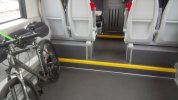This was posted on a Facegroup page highlighting initial test runs of the 756 to Swindon from one of the drivers.
A couple weeks back on 002 we left Newport on battery with 77% . Somewhere around Wotton Bassett the engine started as batteries down to 28%
The engine will maintain battery levels 30-35% . Once at Swindon put the pan up and batteries were fully recharged in about 10-15 mins .
Very little difference in performance on battery to pantograph operation .
Lovely unit to Drive
A couple weeks back on 002 we left Newport on battery with 77% . Somewhere around Wotton Bassett the engine started as batteries down to 28%
The engine will maintain battery levels 30-35% . Once at Swindon put the pan up and batteries were fully recharged in about 10-15 mins .
Very little difference in performance on battery to pantograph operation .
Lovely unit to Drive



